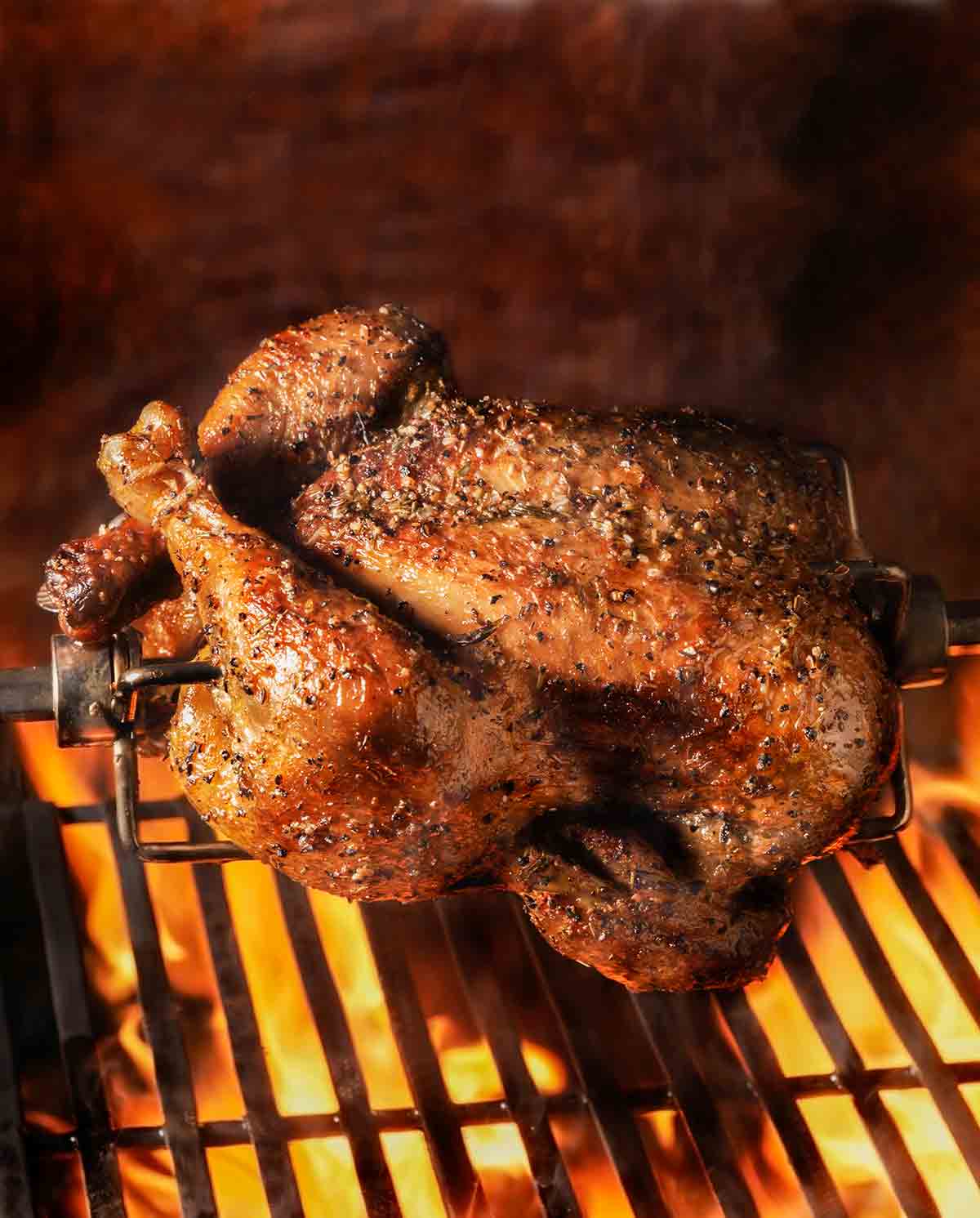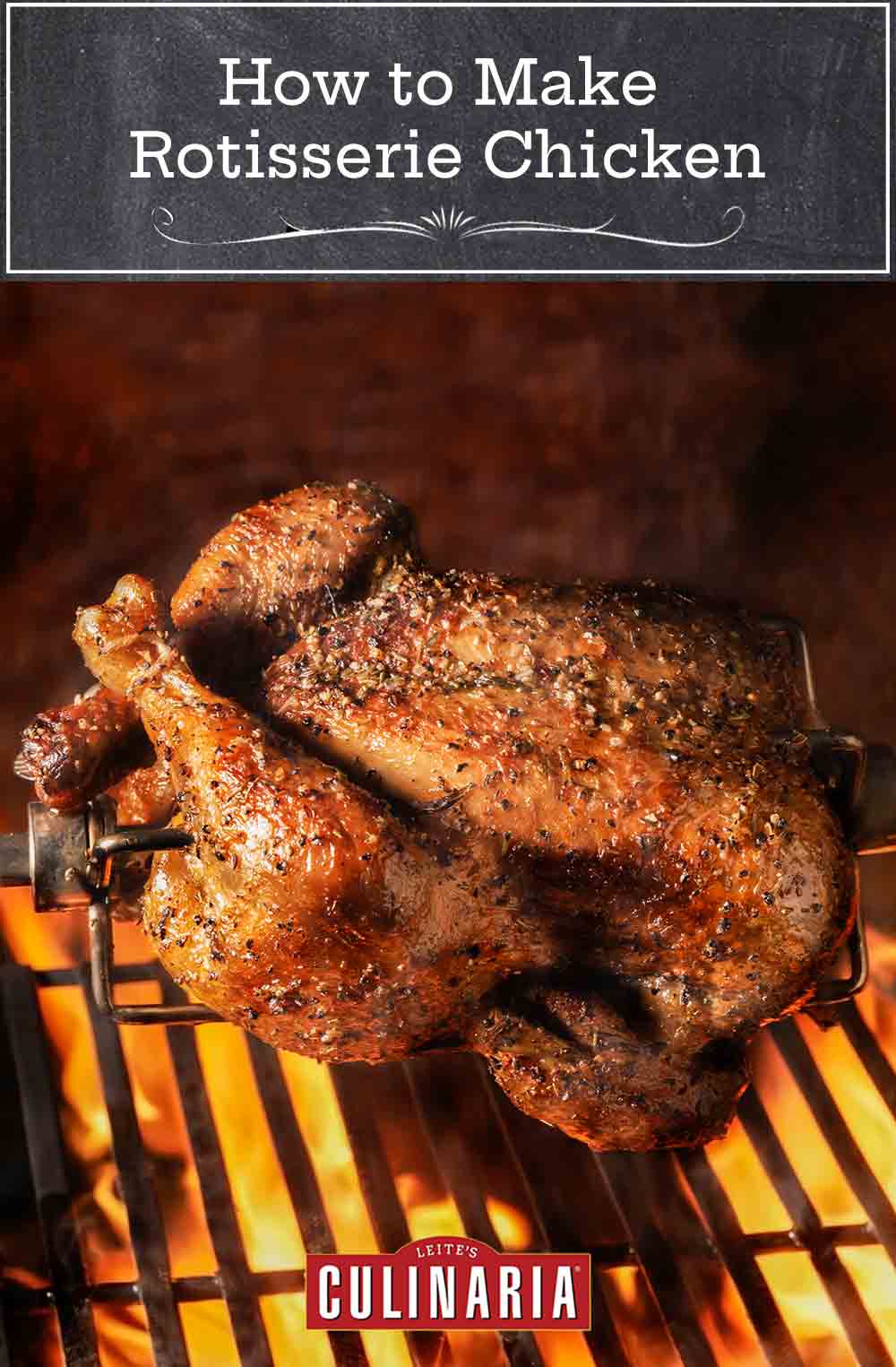
After tucking into RoChix from other places for comparison, one major difference surfaced: Citarella brines their birds. So that’s what we wrassled with first. We tried all kinds of combinations of herbs and spices, as well as varying amounts of salt, until we finally hit upon what comes closest to (and some of our NYC guests swear is even better than) Citarella’s: lots and lots of thyme, a handful of garlic cloves, a bit of rosemary, a pittance of whole black peppercorns, salt, and sugar. (Curiously, Jamie commented that adding sugar is unusual for chicken brining, but we found that it helps give the bird an incredibly crisp golden-brown skin.)
After we seared the brine recipe into our brains, we began knocking these roasted suckers out of the oven left and right. But we realized a lot of chicken-y goodness was being left in the pan. (We took a page from Ina Garten’s book—literally—and tossed homemade croutons with the pan drippings to great effect and copious rounds of applause.) But that still didn’t solve our dilemma: The more fat and juices that dripped off the chicken into the pan, the less juicy and flavorful the bird. Plain old physics, right?
To fix that, we bought a vertical rotisserie. (What can I say? Counter space was at a premium.) It proved to be a bust. All those incredibly chickalicious juices just sluiced off the bird, leaving the top utterly dry and stringy. That’s why when I bought the Weber Summit S-670, I made sure it was kitted out with a rotisserie.

On the appointed day, with rotisserie saber in hand and forks at the ready, Jamie showed me how to truss the chicken, slide it onto the saber, secure it with the forks, and let it rip. Because it’s a horizontal rotisserie, all parts of the bird are basted in a continual bath of goodness from stem to stern as it rotates.
After about two hours in the Weber “sauna of flavor,” theRoChix was evenly cooked, bursting with juices, and had crisp, beautifully browned skin. And this was no one-off. Since Jamie’s visit, The One and I have made RoChix again and again and again—to even greater applause. (Flowers have yet to be thrown at my feet, though.) While the bird is resting on the cutting board, all that’s needed is to pop an excellent bottle of wine, grill some veg-edibles, drag the table into the middle of the backyard, and dinner is served.
P.S. All right, I’ll admit it, I’m showing off a bit here. (But you would, too, if you had a rotisserie worthy of the gods.) I can assure you don’t need one to make fabulous grilled chicken. Try Bacon-Wrapped Chicken Wings or Grilled Roasted Chicken. But do yourself a favor and brine your chicken first. It makes a whopping difference.














Brine Recipe
For all who asked, here it is. Keep in mind that I like to do things quick and easy. So my “recipe” for brining is a loose and fast style. For example, many people put herbs in the brine and boil it. But quite frankly, I don’t bother, and no one knows the difference. Many chefs and in-the-know cooks might cringe and do it very differently. But for me, it works.
INGREDIENTS
1 cup kosher salt
3/4 cup sugar
5 or so large garlic cloves, smashed
10 whole black peppercorns
A large handful of a single herb, such as thyme, oregano, rosemary, or parsley, or a combination of several (Thyme has always worked best.)
4-to-5-pound whole chicken (I prefer organic)
4 tablespoons butter, room temperature
Freshly ground black pepper
METHOD
1. Combine the salt and sugar in a pot roomy enough to allow the chicken to be completely covered with water. Add about an inch of lukewarm water and stir until the salt and sugar are dissolved. (The water should be completely clear.)
2. Add the garlic, peppercorns and herbs. Stir to combine.
3. Fill the pot about half way with cool water. Place the chicken in the pot and fill it with more cool water until the chicken is covered. Cover the pot and place it in the fridge for at least six hours, or, preferably, overnight.
4. Remove the chicken from the pot and pat it dry with a paper towel. Some say you should rinse it at this point. I don’t because I like the full flavor.
5. Stir the butter to make a paste. You could add chopped herbs to the butter, if you like. It’s always a nice touch. Gently lift the skin covering the breast and legs and rub the butter mixture into the meat. Also make sure to put some in the cavity of the bird. Truss the chicken and smear the remaining butter all over the bird. Sprinkle with the pepper.
5. Roast the chicken as you normally would or, if you have a rotisserie, follow the instructions in the video. Cut and enjoy!
Yield: A chicken this size serves 4 to 6—supposedly—but I think 4 is more realistic. (Sometimes, just two!)
Yahoo! It would appear the clamoring masses will be appeased! thank you.
Here’s hoping!
Wow! Having just noticed that the brine recipe is posted, I have to say… The One is number one in my book. Can’t wait to try it out. Thanks so much.
Well put! He is number one in my book, too. Thank you, The One. I will be grateful eternally, and especially when I eat the grilled chicken. All three installments on grilling were great! Thanks to David, Jamie, and The One.
Susan, it was our pleasure. We had a great time doing it. Keep an eye out in the Multimedia section of the homepage for future videos.
Thank you for your efforts, David. Tell him we will keep it in mind that it is always subject to change. 🙂
I adore a buttermilk-‘brined’ chicken. It’s my roast chix go-to. Dump the bird & the milk in a big zipbag & set it in the fridge for a day or two. Drain, pat dry & oven roast, or grill, as you like. If you spatchcock it before you put it in the bag, & lay it out nicely on the grill grates, it makes a dashing presentation at table, all from the simplest of beginnings. It’s just chemistry. Don’t forget the Kosher salt & freshly ground pepper.
ps. @The One..nudge nudge, wink wink, say no more, ya know what I mean?
Sounds a great recipe. I have to try it.
And, yes, I’ve made The One aware that he has a social responsibility to supply his brine recipe. But the refrain I keep hearing is, “It changes a little bit every time!” But I have alerted him to the severity of this issue, and he promises to get back to everyone soon.